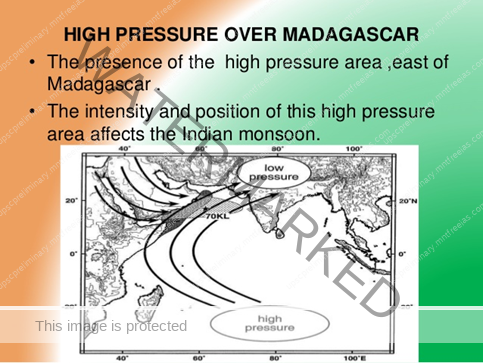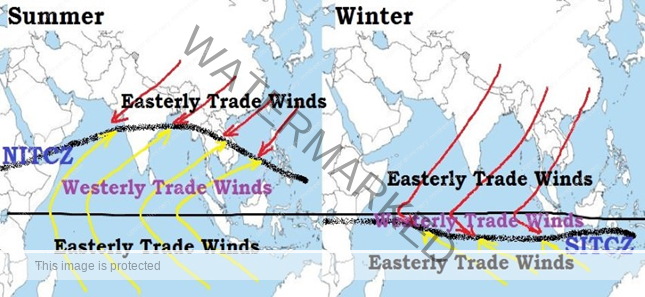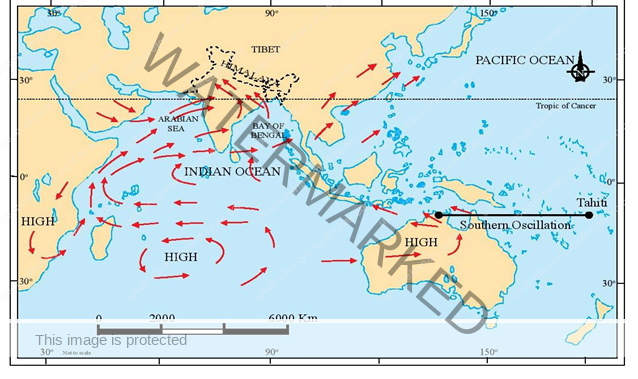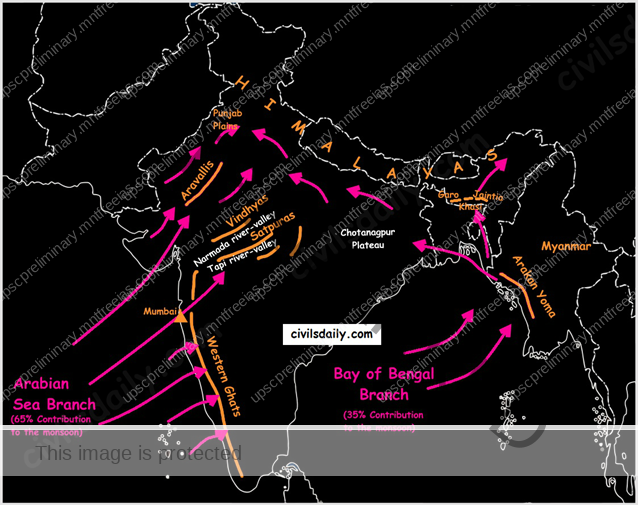- SEASONAL WIND
- INTER TROPICAL CONVERGENCE ZONE (ITCZ)
- RETREATING MONSOON SEASON
UNIT 4 – CLIMATOLOGY – PART 18
SEASONAL WIND
The climate of India is strongly influenced by monsoon winds.
The sailors who came to India in historic times were one of the first to have noticed the phenomenon of the monsoon. They benefited from the reversal of the wind system as they came by sailing ships at the mercy of winds. The Arabs, who had also come to India as traders named this seasonal reversal of the wind system ‘monsoon’
The monsoons are experienced in the tropical area roughly between 20° N and 20° S.
To understand the mechanism of the monsoons, the following facts are important.
(a) The differential heating and cooling of land and water creates low pressure on the landmass of India while the seas around experience comparatively high pressure.
(b) The shift of the position of Inter Tropical Convergence Zone (ITCZ) in summer, over the Ganga plain (this is the equatorial trough normally positioned about 5°N of the equator – also known as the monsoon trough during the monsoon season).
(c) The presence of the high-pressure area, east of Madagascar, approximately at 20°S over the Indian Ocean. The intensity and position of this high-pressure area affects the Indian Monsoon.
(d) The Tibetan plateau gets intensely heated during summer, which results in strong vertical air currents and the formation of high pressure over the plateau at about 9 km above sea level.
(e) The movement of the westerly jet stream to the north of the Himalayas and the presence of the tropical easterly jet stream over the Indian peninsula during summer.
Mechanism
Onset of the South-West Monsoon
- The location of ITCZ shifts north and south of the equatorwith the apparent movement of the Sun.
- During the month of June, the sun shines vertically over the Tropic of Cancerand the ITCZ shifts northwards.
- The southeast trade winds of the southern hemisphere cross the equator and start blowing in southwest to northeast direction under the influence of CORIOLIS FORCE.
- These winds collect moisture as they travel over the warm Indian Ocean.
- In the month of July, the ITCZ shifts to 20°-25° N latitude and is located in the INDO-GANGETIC PLAINand the south-west monsoons blow from the Arabian Sea and the Bay of Bengal. The ITCZ in this position is often called the Monsoon Trough.
- The shift in the position of the ITCZ is also related to the phenomenon of the withdrawal of the westerly jet stream from its position over the north Indian plain, south of the Himalayas.
- The easterly Jet Stream (Somali Jet) sets in along 15°N latitude only after the western jet stream has withdrawn itself from the region. This easterly jet stream is held responsible for the burst of the monsoon in India.
- As these winds approach the land, their southwesterly direction is modified by the relief and thermal low pressure over northwest India. The monsoon approaches the Indian landmass in two branches:
- THE ARABIAN SEA BRANCH –The monsoon winds originating over the Arabian Sea.
- THE BAY OF BENGAL BRANCH –The Arakan Hills along the coast of Myanmar deflect a big portion of this branch towards the Indian subcontinent. The monsoon, therefore, enters West Bengal and Bangladesh from south and southeast instead of from the south-westerly direction.
- Another phenomenon associated with the monsoon is its tendency to have ‘BREAKS’in rainfall. The monsoon rains take place only for a few days at a time. They are interspersed with rainless intervals. These breaks in monsoon are related to the movement of the monsoon trough.
Despite an overall unity in the general pattern, there are perceptible regional variations in climatic conditions within the country.
RETREATING MONSOON SEASON
- The retreating southwest monsoon season is marked by clear skies and rise in temperature.
- The land is still moist. Owing to the conditions of high temperature and humidity, the weather becomes rather oppressive. This is commonly known as the ‘OCTOBER HEAT’.
- In the second half of October, the mercury begins to fall rapidly, particularly in northern India.
- The weather in the retreating monsoon is dry in north Indiabut it is associated with rain in the eastern part of the Peninsula. Here, October and November are the rainiest months of the year.
- The widespread rain in this season is associated with the passage of cyclonic depressions which originate over the Andaman Sea and manage to cross the eastern coast of the southern Peninsula. These tropical cyclones are very destructive.
- The bulk of the rainfall of the Coromandel Coast is derived from these depressions and cyclones.
- Unlike the rest of the country, which receives rain in the southwest monsoon season between June and September, the northeast monsoon is crucial for farmingand water security in the south







